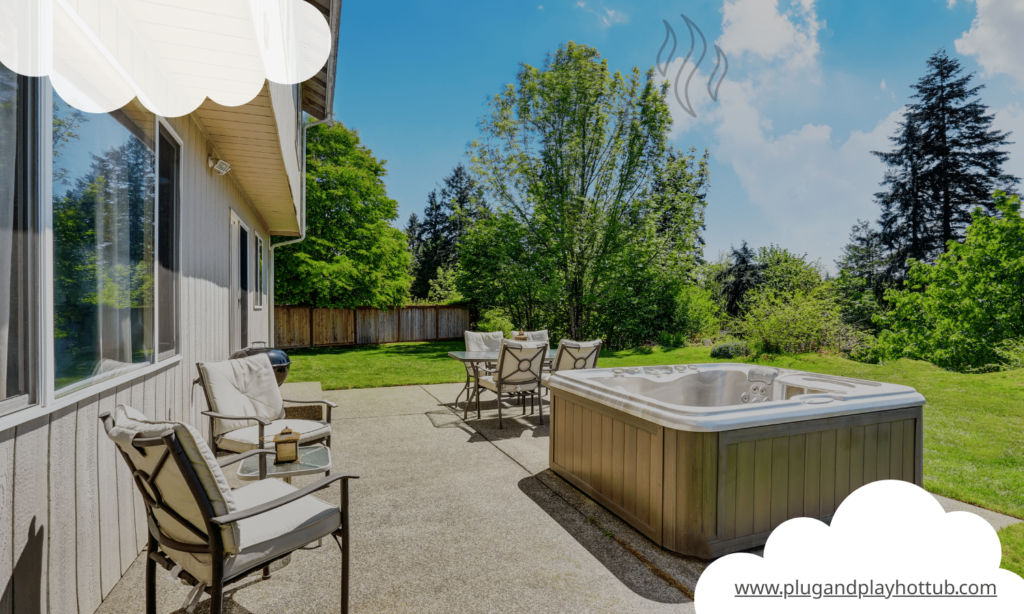
A plug and play hot tub, also known as an inflatable hot tub or portable spa, offers relaxation in your backyard without major installation.
However, keeping the water chemistry balanced is essential for comfort and safety. An out-of-range pH can cause skin and eye irritation, corrosion damage, cloudy water, and ineffective sanitizers. Thankfully, raising the pH in a plug and play hot tub is straightforward with the right supplies and some careful monitoring.
What is the Ideal pH Range?
Before adjusting your hot tub’s pH, it’s important to understand the target range. The recommended pH for hot tubs is between 7.4 and 7.6. This slightly alkaline level helps sanitize the water and prevents damage to the hot tub and your skin.
If the pH drops below 7.2 or rises above 7.8, it’s time for correction. Use a quality test strip or digital tester to track pH over time. Proper calibration if using test strips is essential for accuracy.
What Causes Low pH in a Hot Tub?
There are a few common culprits when it comes to lowering pH in a plug and play hot tub:
- Sanitizers: Chlorine and bromine sanitizers gradually lower pH over time. As they destroy contaminants, acidic byproducts are created. The type and dose of sanitizer impacts rate of pH change.
- Bather Load: Sweat and oils carry acidic residues that accumulate in the water over many hot tub sessions, dropping the pH. The more the tub is used, the faster pH can decline.
- Poor Water Balance: If total alkalinity or calcium hardness is off, pH becomes unstable and difficult to maintain. A professional can diagnose and correct underlying balance issues.
- Infrequent Testing: pH can drift when not monitored regularly. Most experts recommend weekly testing to stay ahead of rapid shifts.
What Are the Signs of Low pH?
Watch for these signs of pH below the ideal range in your plug and play hot tub:
- Cloudy water
- Eye or skin irritation upon use
- Damage to metal components and seals
- Musty odors that return quickly
- Sanitizers stop working effectively despite proper levels
If you observe any symptoms of low pH, it’s important to test and adjust the water promptly. Ignoring pH problems can allow harmful bacteria to multiply.
How to Raise Hot Tub pH in 5 Steps?
Raising pH in a plug and play hot tub is a straightforward process with sodium carbonate or sodium bicarbonate. Here is a simple 5 step method:
1. Test the Current pH
Use an accurate test strip or digital tester to determine the existing pH. This allows you to see how much it needs to be raised and track progress. Calibrate and use test strips properly for dependable readings.
2. Add the pH Increaser
Slowly sprinkle in sodium carbonate, also sold as pH/alkalinity Up, while running the hot tub jets. Go slowly to avoid overshooting the target level. Add in small increments to control the increase.
3. Retest after 5 minutes
After allowing time for circulation and dilution, test the pH again to see if further adjustment is needed. Make sure pH increaser is fully diluted before retesting.
4. Repeat as Needed
Keep adding small amounts of pH increaser every 5-10 minutes until the target range is achieved. Don’t add too much at once. Patience and gradual increases prevent pH spikes.
5. Test Again in 24 Hours
Check the pH again the next day to confirm it remains stable. Additional minor tweaks may be necessary over the next few days as pH settles.
How much pH increaser do I add?
Start with 1 teaspoon per 300-500 gallons of water. Adjust in small increments from there, allowing time to circulate and retest between additions. Go slowly, as too much can overshoot the mark.
Maintaining Proper pH Balance
Once achieved, the ideal pH range must be maintained through these best practices:
- Test pH 1-2 times per week
- Shock sanitize water 1-2 times per month
- Change hot tub water every 3-4 months
- Balance total alkalinity and calcium hardness
- Follow the hot tub manufacturer’s care instructions
Staying vigilant with regular hot tub maintenance prevents pH fluctuations and keeps soaking enjoyable.
| Test | Frequency |
|---|---|
| pH | 1-2 times per week |
| Sanitizer Levels | Before each use |
| Shock Water | 1-2 times per month |
| Total Alkalinity & Calcium Hardness | 1-4 times per year |
| Change Water | Every 3-4 months |
When to Call a Hot Tub Professional?
If your efforts to raise pH don’t seem to stick for more than a day or two, underlying problems may exist. Contact a hot tub technician if:
- You cannot get the pH to stop dropping rapidly
- The water has a high calcium hardness level
- Total alkalinity is off and resisting adjustment
- Cloudiness and odor return quickly after fixing the pH
A professional can diagnose and correct related hot water chemistry issues, recommend sanitizers and other supplies, or troubleshoot mechanical problems. They can ensure safe, clean hot tub water for years of relaxation. Consider a maintenance plan for periodic professional water testing and tuning.
Frequently Asked Questions
How do I know if my pH is too high?
A pH over 7.8 is considered too high for hot tub health and safety. Symptoms include:
– Cloudy Water
– Scale Buildup
– Eye Irritation
– Skin Dryness or Itching
– Ineffective Sanitizer levels
High pH prevents proper sanitation. Just like low pH, ignore high levels for too long and bacteria can flourish.
What causes high pH in a hot tub?
The main causes of rising pH in a plug and play hot tub are:
– Excessive use of pH/Alkalinity Up
– Low bather load allowing dilution of chemicals
– Infrequent testing and chemical replenishment
– High calcium hardness pulling pH up
Why does my hot tub’s pH keep changing?
Frequent pH fluctuations, even with regular testing and adjustment, point to underlying water balance issues. Total alkalinity out of range, varying calcium hardness, and problems with circulation can all cause pH to bounce around. Call a hot tub professional for help getting to the root of the problem.
Can I use baking soda to increase the hot tub pH?
While baking soda (sodium bicarbonate) does increase pH, it has some downsides for hot tub use. Baking soda also raises total alkalinity rapidly. This can make pH hard to stabilize. It also does not dissolve as readily as sodium carbonate products designed for hot tubs.
Is it OK to soak in a hot tub with high pH?
Soaking in water with a pH up to 7.8 is generally safe, but can start to cause issues with extended exposure times. Once pH is above 8.0 health risks increase significantly. If your hot tub pH is reading high, stay out of the water until it can be lowered back into the ideal range between 7.4 and 7.6.
Conclusion
It’s easy to raise low pH in your plug and play hot tub for safe, enjoyable soaking. Simply add pH/alkalinity Up incrementally while testing between adjustments. Maintain the ideal range weekly and watch for signs of pH drops or spikes.
Call a hot tub professional if pH won’t stabilize or related water chemistry is off. Consistent testing and balance keeps hot tub water clean. Consider getting a maintenance plan for periodic professional water tuning.



